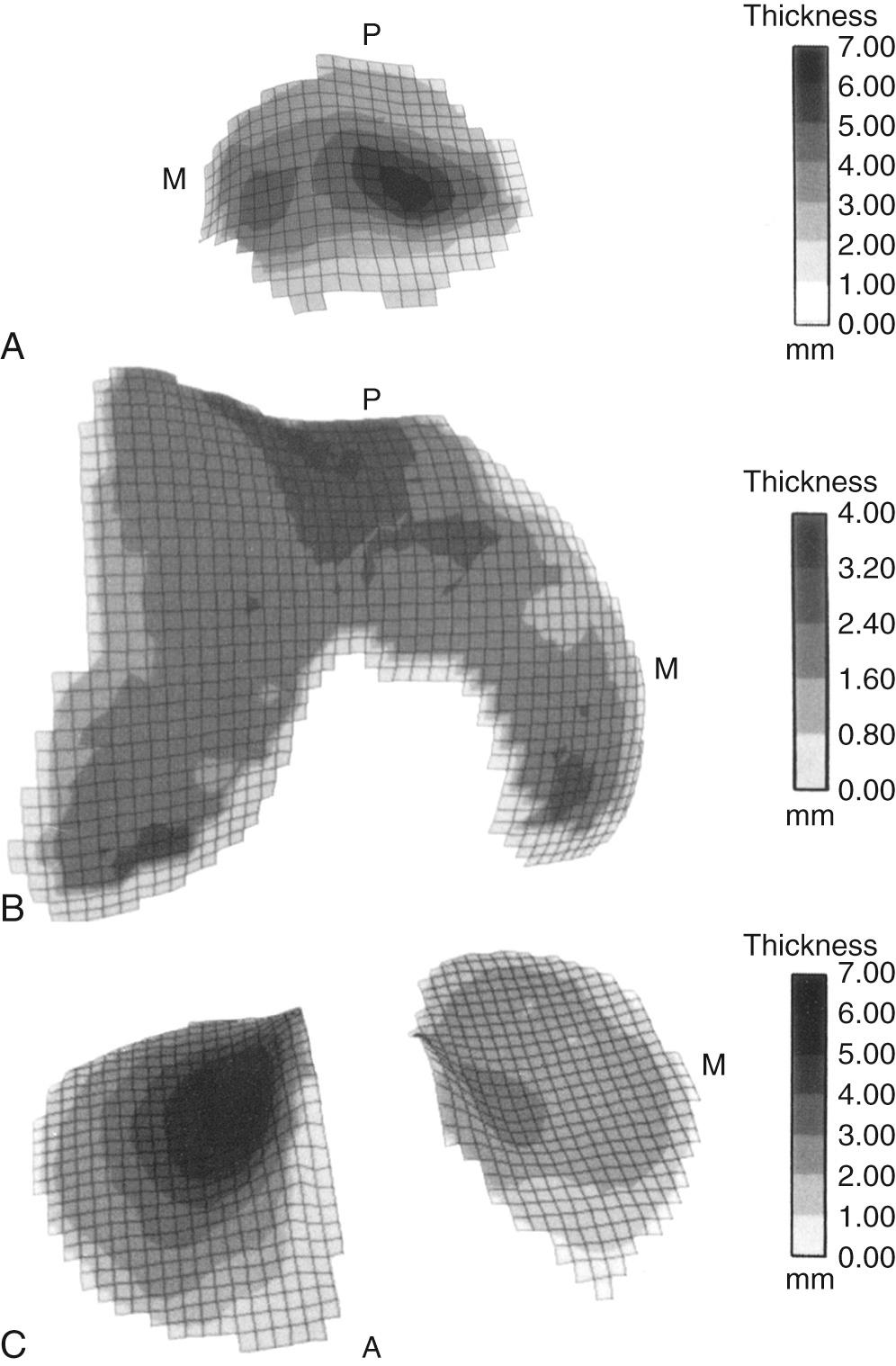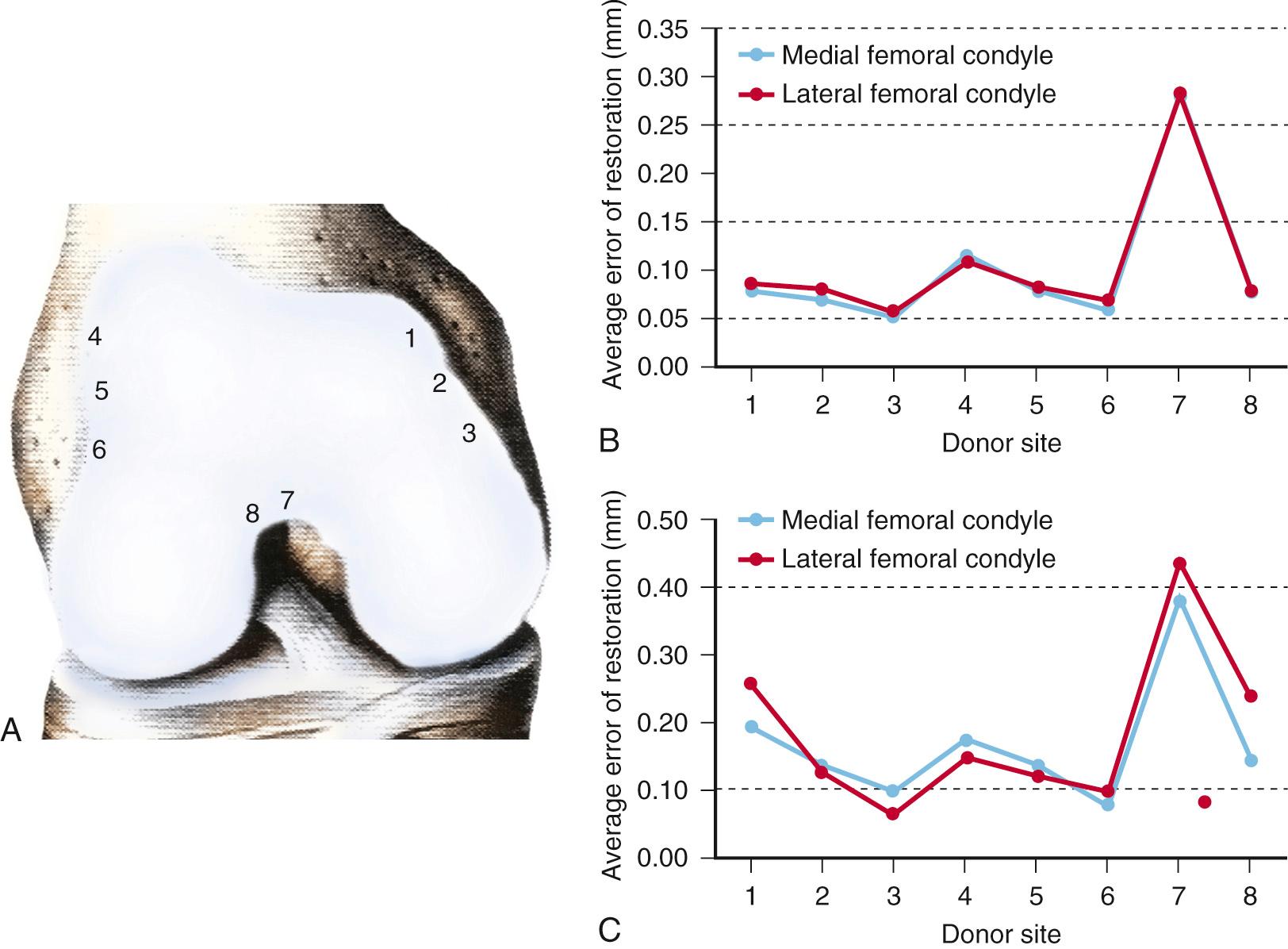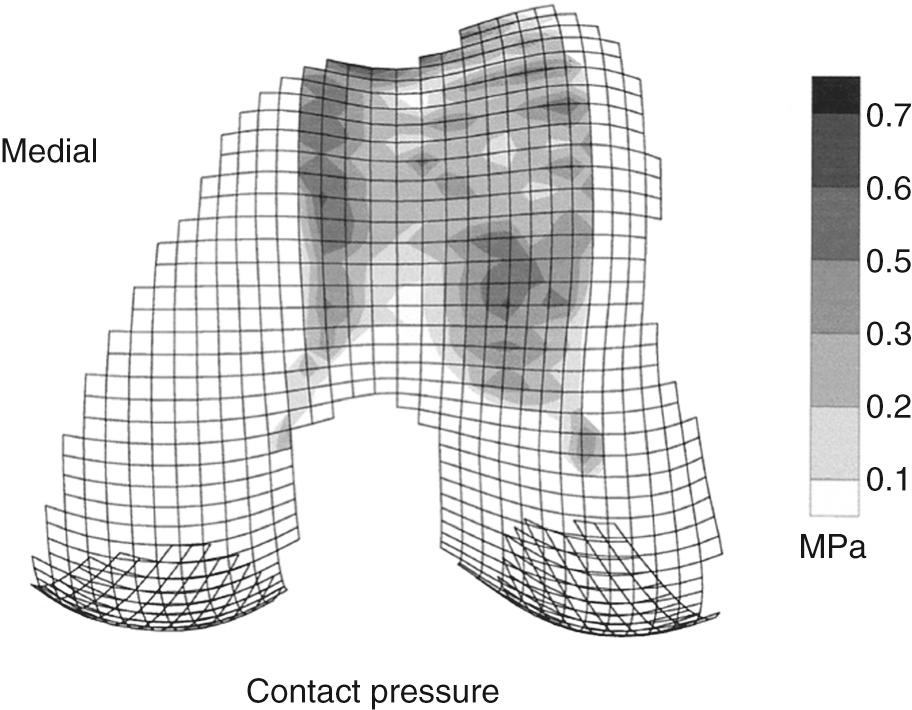Physical Address
304 North Cardinal St.
Dorchester Center, MA 02124
The treatment of symptomatic focal articular cartilage defects continues to present a clinical dilemma for many orthopedists. Surgical approaches to this problem can be categorized into those that attempt to resurface focal defects through tissue repair or regeneration and those that reconstitute articular cartilage surfaces through transplantation of intact osteochondral grafts. The former includes repair strategies, such as marrow stimulation, and cell-based therapies, such as implantation of chondrocytes expanded ex vivo . The results of these resurfacing procedures have been associated with tissue repair predominated by fibrocartilage, which has been shown to have inferior wear characteristics compared to hyaline tissue. Osteochondral autograft plug transfer (OAT) involves the direct transplantation of osteochondral segments from less loaded regions of cartilage to areas with symptomatic focal defects. Despite concerns of donor site morbidity and limited availability, this method has been demonstrated to reliably restore native hyaline cartilage architecture and the underlying subchondral bone.
Early work on autologous hyaline cartilage transplantation to the femoral or tibial condyles involved direct transfer of patellar osteochondral grafts. First described using a pedunculated patellar graft by d’Aubigné in 1945, Campanacci et al. published a case series of 19 patients who underwent free patellar graft trasfer. The indications primarily included giant cell tumors and involved resection of almost the entire osteochondral segment of the patella followed by screw fixation to either the tibial or femoral condyle. Attempts to restore native articular cartilage contour were made through careful orientation of the patellar graft, but obvious donor-recipient mismatches were observed. Overall results were noted to be successful; however, decreased range of motion was found to be the primary postoperative complaint.
Later reports described the transfer of autogenous osteochondral fragments for treatment of osteochondritis dissecans (OCD) of the knee. Yamashita et al . in 1985 described two patients who underwent graft harvest from the superomedial femoral trochlea in a region which “in extension was in contact with neither patella nor meniscus.” Donor sites were filled with iliac crest bone graft, and all segments were fixed using orthogonal mini-cancellous screws. Second-look arthrotomy for screw removal revealed macroscopically intact hyaline cartilage with mild irregularities at the graft-native tissue interface. Slight surface contour irregularities were noted at both donor and graft sites, but with negligible clinical sequelae. Outerbridge et al . in 1995 described the transfer of an osteochondral graft from the lateral facet of the patella to repair a large osteochondral defect in the ipsilateral femoral condyle in 10 patients. A manual press-fit technique was used for graft fixation. Preoperative and postoperative function was assessed using the Cincinnati knee score, with an average improvement from 43 points (range 24 to 64) to 93 points (range 79 to 100). All patients were satisfied with the procedure, in which 70% were able to resume full, unrestricted activity. Success was offset by increased patellofemoral pain and progression of degeneration of the medial facet of the patella. Second-look arthroscopy revealed solid graft fixation and intact surface hyaline cartilage.
Current OAT procedures benefit from improvements in technique and instrumentation. Although the principle of restoration of hyaline cartilage by direct transfer of less significantly loaded areas of articular cartilage remains unchanged, the use of smaller grafts decreases donor site morbidity and allows for more limited exposure. Improvements in surgical technique have resulted in more predictable success rates and fewer complications, with greater attention focused on restoring native articular cartilage topography. Indications for resurfacing have also expanded, with more defined pathoetiology and precise approach in regard to site, size, and geometry of pathologic sites. In this chapter, we review the current approach to OAT, including indications, technical considerations, pearls and pitfalls, postoperative regimens, and clinical results.
Numerous treatment algorithms have been proposed for the management of articular cartilage lesions. Smaller lesions (<10 mm) are typically managed with simple débridement, citing the limited increase in biomechanical loading and rim stresses around the edges of the defect. Primary treatment options typically include marrow stimulation techniques such as microfracture, which has been shown to provide good symptomatic relief and restoration of function in defects with perimeter well-defined edges and good containment. However, recent studies have raised concerns regarding the durability of the fibrous/fibrocartilagenous repair tissue. Larger lesions (surface area >200 mm 2 ) and those with defects extending into subchondral bone represent a more complex scenario that microfracture and/or débridement may not adequately be able to treat. In general, the literature has shown good initial results after microfracture up to 18 to 24 months, but multiple studies examining longer term data have shown that outcomes deteriorate with time, with worsening pain and decreased activity as little as 1 to 3 years after surgery.
Osteochondral autograft transplantation is indicated for the management of focal nondegenerative articular cartilage lesions of the medial or lateral femoral condyles, the trochlear groove, and patella. The optimal size of pathologic lesions that may be successfully treated range from 10 to 25 mm diameter lesions to 150 to 250 mm 2 area lesions. Overall, optimal lesion size indicated for treatment includes symptomatic lesions that are 50 to 250 mm 2 . Smaller OCD lesions and osteochondral fractures represent a good indication for OAT because restoration of both the surface hyaline and underlying subchondral bone can be addressed. A variation on the typical OAT procedure has also been described for the treatment of unstable OCD lesions. Rather than conventional hardware fixation, single or multiple osteochondral plugs may be used as biological pegs to secure OCD lesions following débridement and backfill of underlying fibrous tissue. Age is a consideration, and patients younger than 50 years old with an absence of degenerative pathology may be indicated for OAT, depending on the quality and availability of donor tissue. OAT has also shown success in patients with malalignment, in which patients undergo concomitant high tibial osteotomy. Minzlaff et al. showed a mean Lysholm score increase of 33 points, representing a significant improvement compared to preoperative scores, in which patients had an average varus malalignment of 4.7 degrees, corrected to 4 degrees of valgus in most cases. The visual analog scale (VAS) pain score decreased by a mean of 4.8 points, and 93% of the patients were satisfied with the results of the operative procedure. Mean survival rates were 95.2% at 5 years, 93.2% at 7 years, and 90.1% at 8.5 years after surgery. Other important factors to be considered when defining treatment indications include compliance with postoperative weight-bearing restrictions and recovery.
In 1982, Lindholm et al. reported on a series of animal model experiments in rats, where different strategies were taken toward reconstituting medial femoral condyle defects. Fixation of a loose osteochondral fragment with a bone peg or tissue adhesive was studied in conjunction with the use of either fresh frozen allografts or autogenous grafts harvested from the lateral femoral condyle. The authors concluded that precise reconstruction of the articular surface was essential, as failures were observed if joint surface congruity was inadequate. Subsequent studies have expanded on our understanding of the factors influencing outcomes from OAT. These include topography, contact pressures, fill pattern, depth of insertion, graft harvest, and graft insertion. Although advances in instrumentation and surgical techniques are essential and important, challenges still remain and several technique-related resurfacing factors must be addressed.
In 1991, Ateshian et al. described an analytical stereophotogrammetry technique through which the articular surface topography and cartilage thickness of the knee joint was mapped ( Fig. 30.1 ). This technique involved estimating three-dimensional (3D) coordinates of points on an object using measurements made in two or more photographic images taken from different positions. Using this technique, the precise 3D topography of the cartilage surfaces of various diarthrodial joints were obtained. In a later study, Bartz et al. described a method for computerized matching of the surface hyaline topography of donor and recipient sites for OAT, allowing for an analysis of which commonly used donor site is best matched to a specific defect recipient site. The authors concluded that cartilage defects in the weight-bearing regions of the medial and lateral femoral condyles are best treated with grafts taken from the most inferior parts of the superomedial and superolateral borders of the trochlea ( Fig. 30.2 ). Similarly, lesions in the saddle-shaped trochlea may be addressed with grafts from the intercondylar notch. More recently, Nishizawa et al. reported on 3D laser scanning techniques and found the central trochlea to more accurately match the anterior femoral condyle, whereas peripheral trochlear donor sites were more congruent with the posterior femoral condylar recipient site ( Figs. 30.3 and 30.4 ).




It has been proposed that matching of cartilage thickness between donor and recipient sites is important to avoid subchondral step-off, which may result in a better loading response. Although no biomechanical or animal studies have proven this to be the case, the structural composition of cartilage and the means by which contact pressures are distributed support this theory. Hydrostatic pressures within cartilage and the rate of increase with joint loading can be expected to vary with different cartilage thicknesses. Studies have shown that cartilage thickness is correlated with local joint load, with central condylar thickness up to 3.65 mm compared to as little as 0.22 mm in the sulcus terminalis. Typical graft sites measure 1.2 to 1.6 mm in cartilage thickness compared to condylar thicknesses in the 1.6 to 2.0 mm range.
The concept of split line orientation of surface cartilage should also be taken into consideration when the goal of more precise osteochondral autografting is preferred. In 1898, Hultkrantz demonstrated a distinct orientation of the collagen fibers along the articular cartilage surface, postulating that this was related to directional variation in stiffness and strength. In 1925, Benninghoff further described the microarchitecture of articular cartilage to include collagen fibers oriented perpendicular to the joint surface in the deep layer, with parallel orientation superficially. Below et al . mapped the split line pattern of articular cartilage at the distal femur, demonstrating a characteristic pattern of collagen fiber orientation (see Fig. 30.3 ). Although this may have no significant clinical effect, it is a theoretical concern that deserves consideration.
Contact pressures of the patellofemoral articulation have been examined by several investigators. Simonian et al . reported that commonly used donor sites along the periphery of the femur at the patellofemoral joint and within the intercondylar notch are not completely free of joint loading forces. Ahmad et al . quantified a patellofemoral contact map exhibiting the differences in contact pressures at various sites along the distal femur, showing lowest contact forces at the superomedial border of the femur as well as along the most inferior part of the intercondylar notch (see Fig. 30.4 ). Garretson et al. measured contact pressures under two different loads through the entire range of knee motion. Although contact pressures were noted to be lower along the medial condyle, there were no significant differences along the far medial or far lateral edges of the distal femur. The authors concluded that harvesting of grafts from the medial femoral flare may have less impact on patellofemoral biomechanics, but limitations exist because the medial condyle is narrower and more sloped than the lateral condyle. The authors recommended that grafts 5 mm in diameter or smaller should be harvested from the medial femoral flare and larger grafts should be harvested from the lateral femoral flare. Overall consensus indicates that all articular surfaces bear some load; however, the edges of the medial and lateral flares bear the least force during patellofemoral articulation and may represent an optimal surface match contour for condylar lesions. Depending on the size of the recipient site and the number and size of donor plugs needed, individualized strategies for harvesting may be devised with the underlying goal of minimizing alterations in patellofemoral biomechanics.
Become a Clinical Tree membership for Full access and enjoy Unlimited articles
If you are a member. Log in here